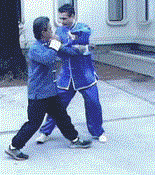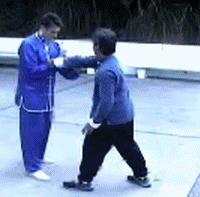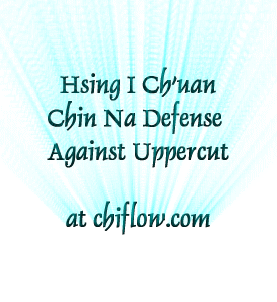|
1. Internal and External Martial Arts
The practice of Nei Jia kung fu may - at least on one level - be described as a martial art built on a yoga-like practice focusing on the use of the joints of the body, rather than on brute force. In this perspective, attacks and counters involving joints and joint locks ought to be completely expected.
The problem with this perspective is not that its wrong but that there is likely to be an implicit assumption that Chin Na may be employed as a series of techniques and practiced as set of drills. The result is a mind set that anticipates an opponent's attack and is ready to quickly retaliate with a prepared counter. This path is valid, but it is the path of external martial arts.
The internal martial arts perspective is more holistic. It is built on a combination of sensitivity with an intuitive knowledge of body dynamics that is developed largely through Tuishou (push hands) practice. In practice, the Tuishou approach is almost entirely situational: anticipating the opponent's actions actually becomes counterproductive. The actions of both the opponents flow together within the context of the situation. In Nei Jia kung fu, the actions are based more on what the opponent is already doing as opposed to anticipating what the practitioner will do.
|
2. Tendons and Bones Joint Manipulation
In this context, the internal kung fu application of Chin Na becomes spontaneous. Chin Na remains a system of the application of bone breaks, muscle or tendon attacks, and a wide variety of submission holds. The difference is that Chin Na can be far more effective when it is used to not so much to win a fight, but to end a fight on your terms rather than on your opponent's terms.

Xingyiquan Eagle/Bear Application
|
|
3. Joint Manipulation
Once the practitioner is able to mask both their movements and their
breathing, they are able to transform their own behaviors and maintain
their central equilibrium, while exposing weaknesses in their
opponent's attack and (or) organism. This is accomplished by being able
to use the opponent's rigid-like qualities or stiffness in their
joints, muscles, and tendons against them.
While the capturing of an attackers joint may appear to be explosive,
or as fast as lightning, the truth is, speed is not necessary
whatsoever. What is needed is the skill of Lu, or following. Following
is often interpreted as moving away from the opponent or turning the
waist when the opponent exerts their greatest force. However, nothing
could be more grossly misinterpreted, or hard to comprehend, than the
art of following. It combines both advancing and retreating in such a
way, that when the practitioner retreats, they advance, and when they
advance they retreat. This is possible, by moving the hands, body, and
feet in an arc-like manner, and simultaneously moving on sharp angles,
which capture the opponent's center (or spine) without telegraphing
your intentions.

|
4. Joint Manipulation

Baguazhang Purple Swallow Application
Again, as described previously, the joints are the doors by which a
practitioner is able to proceed. If an obvious opening does not exist
than a hidden one does. For instance, it is possible to hide your own
force in such a way, that when you are grabbed, you are able to relax
and yet give no outward show of the fact that the opponent is having an
effect. This may appear as ignoring what the opponent is doing.
However, if you relax at the joint, and wait for them to show their
force, you might have a better route into their center, than if you
reacted with a predetermined technique that is supposed to be
foolproof, however, when tested, may fall apart against a wide variety
of different opponents. The classic says, “When they move, you follow
them, and by doing so arrives first.” First, by closely awaiting a
chance to snatch the opponent’s joint.
Having knowledge of how joints work is very practical, but also
learning to have patience for things to develop is even more useful.
So, while a practitioner may have a strong grip, if they cannot follow
closely, they may leave the door open for an escape or a reversal. By
moving, as if following, when the opponent moves, you are better able
to change the grasp if needed, tighten the grip or deepen the
effectiveness of the hold.
|
|
5. Exploiting Vulnerabilities In An Opponent's Situation
Why do this? If you can relax and wait for your opponent to show their force, you usually
have a clear route into their center. This leads to a counterattack approach in internal
kung fu that is entirely situational and depends on the details of the opponent's attack.
The external kung fu alternative approach is technique driven. One reacts with a
predetermined technique that is supposed to be a foolproof counter for the technique
your opponent has employed. However, when tested, this approach may fail for a
variety of reasons. Every counter has another counter. A useful counter may fail because
of unexpected situational details. Speed, power and execution are significant factors in
applying techniques, but a situational component remains an important factor in achieving
success.
The internal kung fu approach concentrates on the situational aspect of the interaction
between opponents. An opponent's speed and power are dealt with using following and
the related approaches described in the classic texts. The classic says, "When they move,
you follow them, and by doing so arrive first."
Having knowledge of how joints work is
very practical, but also learning to have patience for the situation to develop is even more
useful. By moving with your opponent, or following, when the opponent moves, you move.
are better able
to change the grasp if needed, tighten the grip or deepen the
effectiveness of the hold.
First, by closely awaiting a chance to
snatch the opponent's joint.
So, while a practitioner may have a strong grip, if they cannot follow
closely, they may leave the door open for an escape or a reversal.
l have against a wide variety of different opponents.

Taiji (Brush Knee) Chin Na: With a minimal amount of movement, use
the opponent's center line and move into a choke hold using the
rigidity of their spine to solidify a forearm grab at the trachea.
|
6. Finishing a Conflict on Your Terms
Bagua (Lake Palm) Chin Na: Twist the opponent's center of gravity
and capture their spine by gently manipulating their neck and lower
back with a small progressive circle that gains in momentum like a
snowball.
What’s difficult to accept is that speed and powerful techniques are of no real consequence against someone who has mastered the ability to follow and to root. Even if you are fast enough to tackle, duck under or go behind the opponent, success will prove elusive. If the opponent has good rooting, they will be able to simply follow you and wait for you to exert force then - once your force and true intentions are exposed - use your own force against you.
I’m not talking about applying this knowledge in dopey-floored arenas where a taking what should be a bad fall can be used to advantage. We now are used to seeing televised mixed martial art events where a fighter who has just been dropped on his head is able to apply a barrage of techniques against their opponent. I often wonder which fighter would have had to be revived if it had an actual fight outside of an arena.
In Neijia kung fu the knowledge and skills that are needed are very different: to be able to stand and root (or fall if need be) on asphalt, concrete, or uneven surfaces; to employ listening and to be able to engage and follow the opponent’s force; and to thus be able use their opponent's force against them.
|
7. Submission and Control of an Opponent
Xingyi (Metal) Chin Na: Absorb and dismantle the opponent at their
elbow, wrist, and shoulder; in order to move linearly into their spine
to solidify the grab and their aggression.
In Neijia kung fu, the next part of intuitive understanding has to do with knowing a great deal about the mechanics of two interacting people. This concerns all the muscles, tendons, joints and bones. It also concerns the complicated dynamics of force, including instability and balance. Knowing the good and bad outcomes associated with following a particular line in a specific situation allows one to make small changes that select one outcome over another.
In the context of Chin Na, this approach creates a subtle way to attack an opponent's joints. It is very versatile and it has a sophistication goes well beyond a simple technique based system of attacks and counters. The outcomes vary, but it is a usually a choice about how much damage you want to inflict on your opponent. One can attack a joint: be it a finger, wrist, elbow, knee, ankle, toe, neck, vertebrate, or even larger joints such as the shoulders or hips.
|
8. Chin Na
In Neijia kung fu, the insight without hurting yourself or an opponent is to practice seizing and control in the push hands model. This is regularly practiced in Bagua Rou Shou, or in Taiji Tuishou or Xingyi Tuishou. Each of these disciplines have their own set of joint hands practice which focus on sensitivity training, and very often teach chin na within these models.
Some of the sensitivity training can be amazingly deft, especially in something like Wu Style Taijiquan’s Five Single Hands or the 13 Double Hands Methods. In practice with a skilled opponent you often can hardly feel what's happening just before things go very wrong. The advanced practice is so light that you can only feel a need to let go: it is common to realize the the loss of balance is happening well after it is too late to recover. The opponent has initiated and issued.
For this reason, it makes it all the more important to practice slowly and feel your own body mechanics from the top of your head (and the tips of your fingers) though the soles of the feet. Repetitiously practicing slow, exact movements which train the body to move more surreptitiously and without the use of any overt force whatsoever. In this way, you not only awaken knowledge of your own inner mechanics, but by practicing with a variety of partners, you begin to discern and listen to a variety of physical statures and the never ending menu of varying reactions that multiple practice partners bring. Knowledge of Chi Kung, and how energy flows along conduits and points located on the body can also be useful in developing a more intuitive understanding of body dynamics.
|










